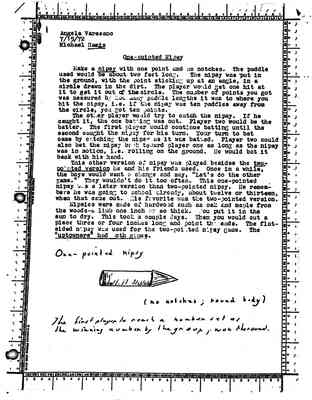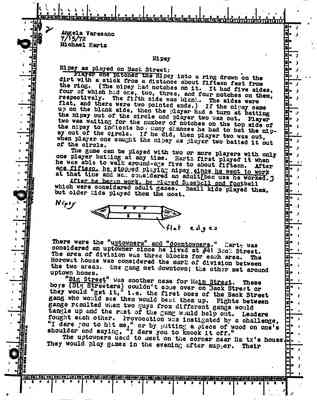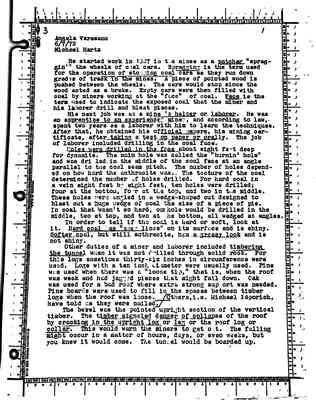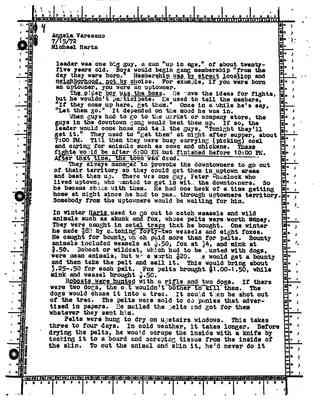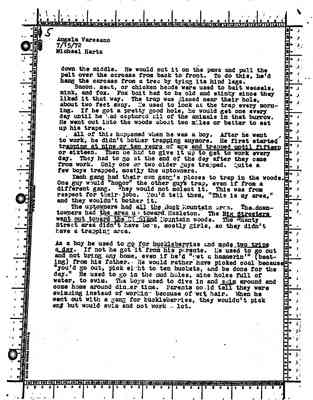Pages
2
Angela Varesano 7/15/72 Michael Hartz ( Hartz is underlined)
One-pointed Nipsy( all words underlined)
Make a nipsy ( underlined)with one point and no notches. The paddle used would be about two feet long. The nipsy was put in the ground, with the point sticking up at an angle, in a circle drawn in the dirt. The player would get one hit at it to get it out of the circle. The number of points you got was measured by how many paddle lengths it was to where you hit the nipsy, i.e. if the nipsy was ten paddles away from the circle, you got ten points.
The other player would try to catch the nipsy. If he caught it, the one batting was out. Player two would be the batter. The first player would continue batting until the second caught the nipsy for his turn. Your turn to bat came by catching the nipsy as it was batted. Player two could also bat the nipsy back toward player one as long as the nipsy was in motion, i.e. rolling on the ground. He would bat it back with his hand.
This other version of nipsy was played besides the twopointed version( previous 3 words underlined) he and his friends used. Once in a while, the boys would want to change and say, "Let's do the other game." They wouldn't do it too often. This one-pointed nipsy was a later version than two-pointed nipsy. He remembers he was going to school already, about twelve or thirteen, when that came out. His favorite was the two-pointed version.
Nipsies were made of hardwood such as oak and maple from the woods-a limb one inch or so thick. You put it in the sun to dry. This took a couple of days. Then you would cut a piece three or four inches long and point the ends. The flatsided nipsy was used for the two-pointed nipsy game. The "uptowners" had both games.( previous 4 words underlined)
One-pointed nipsy (drawing) (no notches; round body)
The first player to reach a number set as the winning number by the group, won the round.
3
Angela Varesano 7/15/72 Michael Hartz
Nipsy
Nipsy as played on Back Street: Player one pitched the nipsy into a ring drawn on the dirt with a stick from a distance about fifteen feet from the ring. (The nipsy had notches on it. It had five sides, four of which had one, two, three, and four notches on them, respectively. The fifth side was blank. The sides were flat, and there were two pointed ends.) If the nipsy came up on the blank side, then the player had a turn at batting the nipsy out of the circle and player two was out. Player two was waiting for the number of notches on the top side of the nipsy to indicate how many chances he had to bat the nipsy out of the circle. If he did, then player two was out, when player one caught the nipsy as player two batted it out of the circle. The game can be played with two our more players with only one player batting at any time. Hartz first played it when he was able to walk around--age five to about fifteen. After age fifteen, he stopped playing nipsy since he went to work at that time and was considered an adult (because he worked). After he began work, he played baseball and football which were considered adult games. Small kids played them, but older kids played them the most.
Nipsy [Drawing that shows three parallel horizontal lines with triangles on each end, with marks inside the lines indicating the notches. "Flat edges" is written below it and a line is drawn from the words to the image]
There were the "uptowners" and "downtowners". Hartz was considered an uptowner since he lived at #41 Back Street. The area of division was three blocks for each area. The Horowat house was considered the mark of division between the two areas. One gang met downtown; the other met around uptown homes. "Big Street" was another name for Main Street. These boys (Big Streeters) couldn't come over on Back Street or they would "get it", i. e. the first ones of the Back Street gang who would see them would beat them up. Fights between gangs resulted when two guys from different gangs would tangle up and the rest of the gang would help out. Leaders fought each other. Provocation was instigated by a challenge, "I dare you to hit me," or by putting a piece of wood on one's shoulder and saying, "I dare you to knock it off." The uptowners used to meet on the corner near Hartz's house. They would play games in the evening after supper. Their
4
Angela Varesano 6/7/72 Michael Hartz
He started work in 1927 in the mines as a patcher "spraggin' " the wheels of coal cars. Spragging is the term used for the operation of stopping coal cars as they run down grades of track in the mines. A piece of pointed wood is pushed between the wheels. The cars would stop since the wood acted as a brake. Empty cars were then filled with coal by miners working at the "face" of coal. Face is the term used to indicate the exposed coal that the miner and his laborer drill and blast pieces. His next job was as a mine's helper or laborer. He was an apprentice to an experienced miner, and according to law, spent two years as a laborer with him to learn the techniques. After that, he obtained his official papers, his mining certificate, after taking a test on paper or orally. The job of laborer included drilling in the coal face. Holes were drilled in the face about eight feet deep for dynamite. The main hole was called the "burnin' hole" and was drilled in the middle of the coal face at an angle parallel to the coal seam pitch. The number of holes depended on how hard the anthracite was. The tecture [texture?] of the coal determined the number of holes drilled. For hard coal in a vein eight feet by eight feet, ten holes were drilled; four at the bottom, four at the top, and two in the middle. These holes were angled in a wedge-shaped cut designed to blast out a huge wedge of coal the size of a piece of pie. In coal that wasn't so hard, one hole would be drilled in the middle, two at top, and two at the bottom, all wedged at angles. In order to tell if the coal is hard or soft, look at it. Hard coal has "s[?] lines" on its surface and is shiny. Softer coal, but still anthracite, has a greasy look and is not shiny. Other duties of a miner and laborer included timbering the tunnel when it was not drilled through solid rock. For this logs sometimes thirty-six inches in circumference were used. Logs with a ten inch diameter were usually used. Pine was used when there was a "loose tip," that is, when the roof was weak and had jagged pieces that might fall down. Cak [?] was used for a bad roof where extra strong support was needed. Pine boards were used to fill in the spaces between timber logs when the roof was loose. Others, i. e. Michael Boporich, have told me they were nailed. The bevel was the pointed upright section of the vertical timber. The timber signaled danger of collapse of the roof by cracking in the upright log or leg or the roof log or collar. This would warn the miners to get out. The falling might occur in a matter of hours, days, or even weeks, but you knew it would come. The tunnel would be boarded up.
5
Angela Varesano 7/15/72 Michael Hartz
leader was one big guy, a man "up in age," of about twentyfive years old. Boys would begin gang membership "from the day they were born." Membership was by street location and neighborhood, not by choice. For example, if you were born an uptowner, you were an uptowner. The older boy was the boss. He gave the ideas for fights, but he wouldn't participate. He used to tell the members, "If they come up here, get them." Once in a while he'd say, "Let them go." It depended on the mood he was in. When guys had to go to the market or company store, the guys in the downtown gang would beat them up. If so, the leader would come home and tell the guys, "Tonight they'll get it." They used to "get them" at night after supper, about 7:00 PM. Till then they were busy carrying (picking) coal and caring for animals such as cows and chickens. These fights would be after 6:00 PM but finished before 10:00 PM. After that time, the town was dead. They always managed to provoke the downtowners to go out of their territory so they could get them in uptown areas and beat them up. There was one guy, Peter, Cheslock who lived uptown, who wanted to get in with the downtowners. So he became ch[?um]s with them. He had one heck of a time getting home at night since he had to pass through uptowners territory. Somebody from the uptowners would be waiting for him.
In winter Hartz used to go out to catch weasels and wild animals such as skunk and fox, whose pelts were worth money. They were caught in metal traps that he bought. One winter he made $82 by catching forty-two weasels and eight foxes. He caught for bounty, which paid more than for pelts. Bounty animals included weasels at $.50, fox at $4, and mink at $.50. Bobcat or wildcat, which had to be hunted with dogs, were mean animals, but were worth $20. He would get a bounty $.25-.50 for each pelt. Fox pelts brought $1.00-1.50, while mink and weasel brought $.50. Bobcats were hunted with a rifle and two dogs. If there were two dogs, the cat wouldn't bother to kill them. The dogs would chase it into a tree. It could then be shot out of the tree. The pelts were sold to companies that advertised in papers. He mailed the pelts and got for them whatever they sent him. Pelts were hung to dry on upstairs windows. This takes three to four days. In cold weather, it takes longer. Before drying the pelts, he would scrape the inside with a knife by tacking it to a board and scraping tissue from the inside of the skin. To cut the animal and skin it, he'd never do it
6
Angela Varesano 7/15/72 Michael Hartz
down the middle. He would cut it on the paws and pull the pelt over the carcass from back to front. To do this, he'd hang the carcass from a tree by tying its hind legs. Bacon, meat, or chicken heads were used to bait weasels, mink, and fox. Fox bait had to be old and stinky since they liked it that way. The trap was placed near their hole, about two feet away. He used to look at the trap every morning. If he got a pretty good hole, he would get one every day until he had captured all of the animals in that burrow. He went out into the woods about two miles or better to set up his traps. All of this happened when he was a boy. After he went to work, he didn't bother trapping anymore. He first started trapping at nine or ten years of age and trapped until fifteen or sixteen. Then he had to give it up to get to work every day. They had to go at the end of the day after they came from work. Only one or two older guys trapped. Quite a few boys trapped, mostly the uptowners. Each gang had their own gang's places to trap in the woods. One guy would "honor" the other guy's trap, even if from a different gang. They would not molest it. This was from respect for their jobs. You'd tell them, "This is my area," and they wouldn't bother it. The uptowners had all the Buck Mountain area. The downtowners had the area up toward Hazleton. The Big Streeters went out toward the Highland Mountain woods. The Shanty Street area didn't have boys, mostly girls, so they didn't have a trapping area. As a boy he used to go for huckleberries and made two trips a day. If not he got it from his parents. He used to go out and not bring any home, even if he'd "get a hammerin' " (beating) from his father. He would rather have picked coal because "you'd go out, pick eight to ten buckets, and be done for the day." He used to go in the mud holes, mine holes full of water, to swim. The boys used to dive in and swim around and come home around dinner time. Parents could tell they were swimming instead of working because of wet hair. When he went out with a gang for huckleberries, they wouldn't pick any but would swim and not work a lot.
